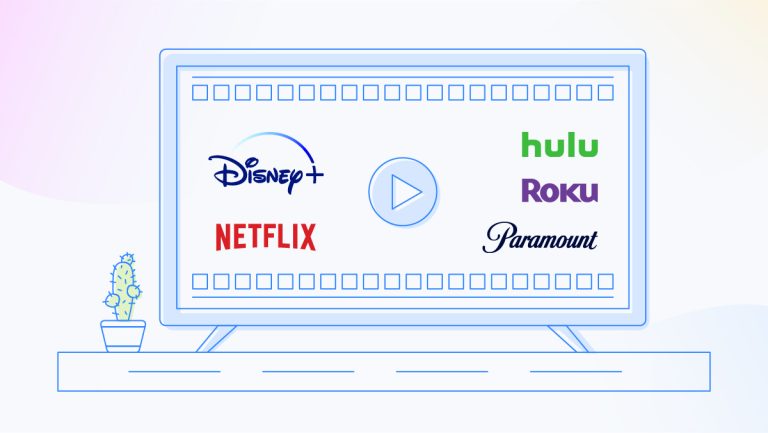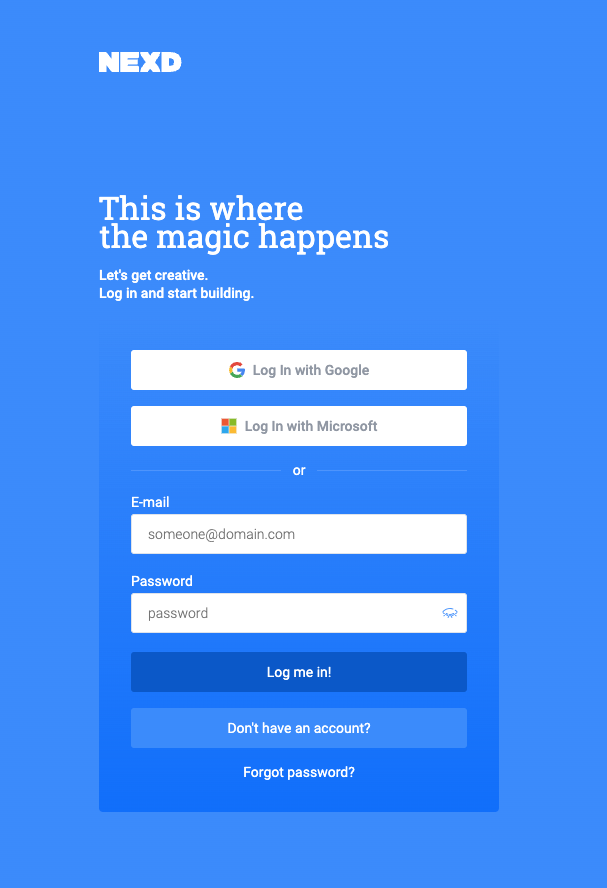
Maximizing Your Brand’s Reach with CTV Advertising: Tips and Strategies for Success
With TV-watching habits shifting, Connected TV (CTV) advertising is the way to reach more viewers. CTV ads are booming in popularity, especially with streaming platforms taking over.
Streaming services like Netflix, Hulu, Apple TV+, ESPN+, and Disney+ offer on-demand content. They cost a fraction of traditional cable costs and let you pick what you watch, putting you in charge of your entertainment.
Additionally, almost everyone in the US—87% of adults—owns one CTV device. It caused CTV ad spending to shoot up to $20.69 billion in the US alone. And it’s not just in the US. Globally, CTV ads now make up 17% of all the money spent on advertising.
These numbers tell us something big: CTV advertisements work.
If you’re new to this channel, continue reading to learn everything about the Connected TV ads.
This blog is going to cover:
- Connected TV advertising definition
- Why should you use connected TV video advertising?
- How does Connected TV advertising work?
- How Are Connected TV audiences targeted?
- How can you get started with the Connected TV advertising strategy with Nexd?
With no more waiting, let’s start right away!
What Is CTV Advertising?
Connected TV (CTV) advertisements are a form of programmatic advertising that targets audiences through internet-connected TV devices, such as smart TVs, gaming consoles, streaming boxes and Fire TV sticks.
Unlike old-school TV ads that air during scheduled programming, this appears during your streaming sessions when you watch your favorite shows on Netflix, Prime, HULU or other similar services.
CTV ads come in various formats, including pre-roll ads that appear before the start of content. Mid-roll ads interrupt the content and post-roll ads after the content completion. You can even display it as overlay banners or interactive ads that encourage engagement when viewers watch.
But, some people mix up CTV ads with OTT and regular TV ads. Next, we’ll explain how they’re different.
CTV advertising vs. OTT advertising
OTT (Over-the-Top) advertising refers to delivering video content over the Internet to various devices, including smartphones, computers, and connected TVs. It is delivered directly to viewers over the Internet, bypassing traditional cable or satellite providers.
Services like Netflix, Hulu, Amazon Prime Video, and YouTube are examples of OTT platforms. Conversely, Connected TV advertising specifically targets ads on television sets, focusing on platforms like Roku, Apple TV, and Smart TVs.
People use CTV and OTT advertising interchangeably but differ in targeting ad delivery and the types of devices they cater to.
Targeting capabilities: CTV and OTT ads allow advertisers to deliver ads to specific households based on demographics, interests, and what people watch. OTT ads cover devices like smartphones, computers, and big TVs, while CTV ads focus only on big screens.
Ad delivery: CTV ads appear on various setups, like Roku, while OTT ads appear on fancy streaming services like YouTube or Hulu.
Ad Styles: CTV ads feel more like regular TV ads and can be longer, like those 30-second ones. In contrast, OTT ads are often shorter and more interactive to match the content they accompany.
Device Reach: CTV ads stick to smart TVs, while OTT ads cover various gadgets, from phones to tablets and computers.
User engagement: With OTT ads on mobile and desktop devices, users can tap or click to visit a brand’s website or app. Users can interact with them on various devices.
Most CTV ads often don’t allow you to click on them, (you can, but it’s not very popular), but some marketers use QR codes instead for engagement. This difference is due to the nature of the devices. Its placement is alongside shows and apps on the viewers’ connected devices.
In the future, as advertising technology evolves, we might see more clickable options in CTV ads, too. It could mean one-click user journeys becoming possible on your big TV screen.
Nonetheless, CTV and OTT advertising offer unique ways to optimize TV advertising strategies, which helps in data-driven decision-making.
CTV advertising vs. Addressable TV advertising
Addressable TV advertising is a form of targeted advertising that allows advertisers to customize ads delivered to individual households while watching traditional TV.
It uses intelligent data and tech to determine who’s watching and shows ads based on age, what you like, or where you live. If you’re into beauty, it might show ads for new beauty products, or if a household has shown an interest in outdoor activities, they might see ads for sporting goods, adventure travel, or related products and services.
Regarding ad delivery, CTV advertising integrates ads into shows or apps on smart devices. At the same time, Addressable TV advertising delivers a traditional TV experience with tailored ads based on specific audience data.
CTV advertising vs. Linear TV advertising
Linear TV advertising refers to the traditional method of delivering television advertisements through scheduled programming on broadcast or cable networks.
It is a content-based method targeting channels and programs based on outdated segments like age, gender, and time.
You can often see this form of advertising as a competitive environment with limited inventory and flexibility. You can access Linear TV through a cable subscription or free-to-air signal, as opposed to through the internet with OTT (Over-the-Top) services.
We believe the explanation has clarified the differences between CTV and OTT advertising. Next up, let’s explore the benefits of CTV advertising now.
Why use CTV advertising?
The popularity of CTV advertising continues to surge, with anticipated spending projected to surpass $30 billion by 2025. It offers several benefits to brands and businesses! Below are the five benefits CTV ads have to offer.
- Precise Targeting and Audience Segmentation
Connected TV advertising services allow advertisers to target specific audiences more precisely than traditional TV advertising. With data-driven insights, advertisers can segment viewers based on demographics, interests, and behaviors. This granular targeting ensures that ads are shown to the most relevant audience, increasing the likelihood of engagement and conversion.
For instance, if a brand wants to reach young adults interested in fitness, CTV ads can be tailored to appear during fitness-related content, optimizing relevance and impact.
- Cost-effective
57% of media buyers find CTV more effective than regular TV in driving website visits and sales. Ads shown on CTV can reach many people at once, which is better than ads displayed on mobile devices. It could also be cross-device.
Plus, paid advertising on streaming-connected TV uses data to show up at the correct times to the right people, unlike regular TV ads that might not reach the intended audience. With Connected TV ad network, there’s no need for big budgets or costly deals. It’s a way to reduce high production expenses and pricey airtime fees.
- High ad watch rates
When it comes to connected TV video advertising, people are tuned in and paying attention about 71% of the time, much more than regular TV ads, which are about 17% higher. When people watch TV, they’re usually more into what’s on and less likely to skip or stop the ads, unlike on other digital platforms.
Plus, when you’re kicking back watching longer shows on TV, it’s easier to sit through the ads. As more people finish watching ads, they’re more likely to pay attention to the message. That could mean they remember the brand better and might be more interested.
- Extensive premium inventory
CTV gives you a lot of great places to put your ads – think popular TV shows and movies. That means more of the right people will see your ad. And with CTV, you’re more sure your ads will get seen. Plus, you can make interactive ads where viewers can tap or play along, getting them more involved.
- Measurement and attribution
Many CTV ads are not currently clickable (while some platforms, such as Hulu, offer interactive living room ads that allow users to explore content by clicking and scrolling), which makes tracking their impact tricky. On Nexd, you can add a CTA to your CTV ads always!
But don’t sweat it! There are other essential things to check, like how much bang you get for your buck with each Connected TV programmatic ad campaign (ROI). These CTV platforms give you real-time numbers and ways to improve your ads.
Tracking attribution is easier than ever with CTV because it identifies where users’ actions start after watching the ad, such as website visits, conversions, or social media subscriptions. Advertisers are finding new ways to ensure they know how well their ads are doing as these platforms get better.
How Does Connected TV-advertising Work?
Connected TV (CTV) advertising delivers targeted ads to viewers streaming content through internet-connected smart TVs or devices like Roku, Apple TV, Amazon Fire Stick, or gaming consoles. Here’s a breakdown of how it typically operates:
Audience Identification: Advertisers collect data to identify precise audience segments based on demographics, interests, and viewing behavior, among other parameters.
Ad Creation: Advertisers create various CTV ads, including video ads, display ads, and interactive ads. It is then showcased to specific audiences and includes actions for viewers.
Ad Delivery: Connected TV (CTV) ads appear on paid and free ad-supported streaming networks and apps, which viewers access through smart TVs and other connected devices.
Measurement and Optimization: Data is gathered from the campaign manager to measure the effectiveness of the connected TV campaigns. Advertisers track ad performance metrics like views, engagement, and conversions. They analyze this data to refine targeting and optimize future ad placements.
How Are Connected TV Audiences Targeted?
Connected TV (CTV) advertising offers various targeting options to reach specific audiences. Here are some insights from the provided sources:
- First-party data and Third-party data
Advertisers use data collected directly from their audience interactions and behaviors. It might include information from their website visits, app usage, or direct customer interactions. It helps tailor ads to specific preferences and behaviors.
External data sources provide additional insights about audiences. This data comes from sources other than the advertiser or platform, offering broader insights into consumer behaviors, interests, and demographics.
Related read: Mobile Ad Serving- The Magic That Gets Your Creatives Onto Mobile Screens
- Frequency caps
A frequency cap restricts how many times a specific viewer sees CTV ads. Keeping ads from overexposure to viewers reduces ad fatigue and reduces their effectiveness.
- Behavioral targeting
Behavioural targeting uses past online activities to predict which TV ads might connect with viewers. However, recent developments, such as Google’s impending changes to cookies, signal a shift in tracking practices. As these changes unfold, advertisers may encounter limitations in analyzing web visits, search history, and past purchases for creating personalized ad experiences.
- IP targeting
IP targeting involves delivering ads based on specific IP addresses associated with households or devices. Local businesses benefit from this type of granular targeting since it allows them to reach their target audience more accurately.
- Demographic targeting
Demographic targeting, a commonly used strategy in Connected TV (CTV) advertising, focuses on traits like age, gender, income, and more. This targeting could be facilitated because CTV platforms have data about users who signed up, allowing advertisers to show ads to specific groups based on their information. While traditional TV ads mainly rely on age and gender for targeting, addressable CTV ads offer more precise targeting, potentially using user data from the platform to improve engagement.
How Can You Get Started with a Connected TV advertising strategy?
Nexd is a creative management platform that offers innovative solutions for display ads, including Connected TV advertising. The platform provides a range of features and benefits that can help businesses build and manage effective CTV ad creatives.
Here’s how Nexd helps with CTV advertising:
Regularly track and analyze your CTV ad performance. Check metrics like engagement rates, views, and conversions. Use these insights and adjust as needed to optimize your campaigns and achieve better results.
- Explore Nexd’s Tools
Familiarize yourself with Nexd’s tools. The platform include features for easy template-based layout creation, video editing and size compression, fast rendering, and the ability to reuse existing campaigns for CTV
- Understand VAST Video Tags
Learn how to utilize Nexd’s vast video tags effectively. Using these tags offers lighter file sizes, faster ad loading, and streamlined tracking and analytics. These will enhance your overall ad experience.
For example, in the image below, you can select VAST video when making a new ad campaign creative.
Image source: Nexd
- Utilize Interactive Features
Explore options to add interactive elements like overlays, clickable elements, product placement, or engaging end cards to boost user engagement.
- Repurpose your existing video ads or create new ones
Adapt to your existing video ads or create new ones for CTV platforms. Ensure your creative is engaging, visually appealing, and compatible with multiple screen sizes.
- Monitor and optimize your campaign
Regularly track and analyze your CTV ad performance. Check metrics like engagement rates, views, and conversions. Use these insights and adjust as needed to optimize your campaigns and achieve better results.
Connected TV advertising: Final Thoughts
As viewers move towards streaming, brands, especially local ones, must grasp CTV advertising to reach their audiences effectively. The good news? CTV isn’t drastically different from traditional TV; it’s even better in some aspects. So, learning how to use, create and run CTV ad campaigns is vital for marketers.
Nexd can help you stay ahead in reaching your audience. Get your free trial today, or contact us for more information about CTV ads!

Get Started
Sign up to Nexd Campaign Manager for a free 14-day trial and start creating environment-friendly and highly engaging programmatic creatives!
